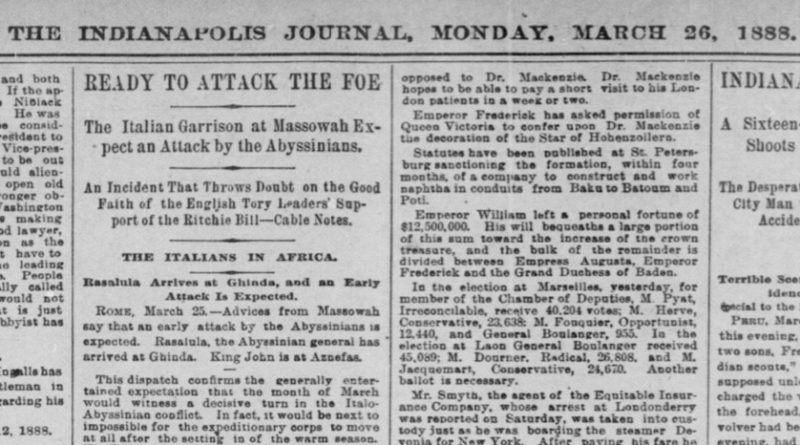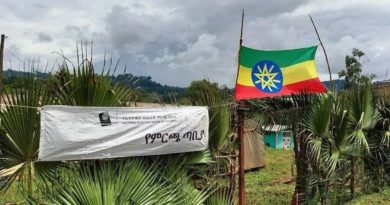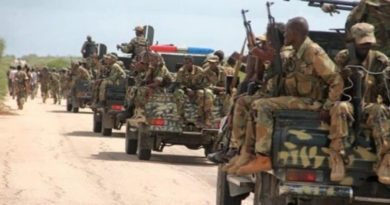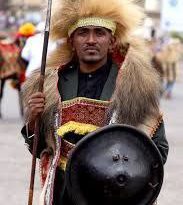OROMO warriors of Abyssinia detailed in oldest western news article on pre-ADWA
“Ready to attack the Foe”
THE INDIANAPOLIS JOURNAL MONDAY, MARCH 26, 1888
The Italian Garrison at Massowah expect an attack by the Abyssinians Ras Alula arrives at Ghinda, and an early attack is expected.
THE ITALIANS IN AFRICA
Rome, March 25, 1888 – Advices from Massowah say that an early attack by the Abyssinians is expected. Ras Alula, the Abyssinian general has arrived at Ghinda. King John is at Aznefas.
This dispatch confirms the generally entertained expectation that the month of March would witness a decisive turn in the Italo-Abyssinian conflict. In fact, it would be next to impossible for the expeditionary corps to move at all after the setting in of the warm season. The Italian headquarters and base of operations still remain located at Massowah, and a line of forts extending crescent-like around and in advance of Massowah, from Arkiko to Saati, at a distance not greater than twenty-five miles from the coast.
The Italian outposts have not yet climbed over the first slopes of the Abyssinian plateau, which rises to the region. Very likely they never will do it, especially during the hot season of the year. On the other hand, the Negus’s soldiers will not come down from their mountainous heights to fight the Italians, covered by the fire of the many forts they have built and armed with big guns all along the semicircular line of their defenses, running from Arkiko to Massowah, with its inland centre at Saati.
The only enemy in sight is assuredly the scouting squadrons of the terrible Wollo-Oromos cavalry, which their queen has herself led into the camp of her suzerain, the Negus of Negast, the King of Kings of Ethiopia. Some travelers have computed that the Oromos cavalry numbers 50,000 horsemen, but it seems, according to Dr. Rohlfs, an authority in regard to Abyssinian affairs, that the whole country could hardly furnish 25,000 horses. At any rate, the Oromos are the Cossacks of Africa. Brought up among horses since infancy they are better centaurs than the majority of Abyssinians. In the Oromo county, it is held as a disreputable thing to go about afoot instead of on horseback. The people are nomads, and this explains why so little is said about them by travelers. But it is generally admitted, says one of the latter, Mr Roger d’Hericourt, that the Oromo race is the finest in Africa. Their county is situated southeast of Abyssinia proper, to which the Oromos are more or less tributary, according to the whims and fancies of their ruler, usually a queen, who takes unto herself one or more prince consorts.The Oromo horses are of shorter stature, but are very fine and spirited. They are often mounted by the wives of the warriors, who gallop at the left or the right side of their husbands in the middle of a battle. The arms of Oromos, like those of the Abyssinians, are the lance, sword and shield. A piece of calico, abundantly impregnated or soaked with rancid butter or stale bacon, is sufficient commonly for the support of Oromo soldiers. The richest among them wear trousers, with another garment like the Scottish kilt. Their hair is sometimes freely floating on their heads and sometimes knotted in three cords, but it is always perfumed with butter. This explains how the approach of Oromos horsemen is always known in advance, even when they cannot be seen at a distance, for they are detected by their smell.
Such are the terrible Wollo-Oromo Abyssinian horsemen.
One of their chiefs, Ras Gobana, is the most popular man in southwestern Africa.Gobana, now a very old man, although quite able to lead his squadrons to battle, began life as a hostler. He commanded some irregular troops, or partisan corps, when Theodros conquered the Oromos and Shoa counties. Gobana, at the head of twenty thousand horsemen, was the only Abyssinian who dared to hold on against the ferocious Negus (Theodros), who had put a price on Gobana’s head. But the latter was a kind of Garbaldi for his soldiers, and no one ever thought of gaining the golden treasure promised by Theodros. After the British war, Menelik made of Ras Gobana the second man in the Kingdom, and appointed him Viceroy of the Oromos and the other counties he had conquered. He is practically independent of the Queen of the Wollo-Oromos, as well as of Menelik, King of Shoa, who has intrusted him with the care of his son, whose life was threatened by the intrigues of the Ankober court.
Ras Gobana concealed the young man in a remote village, where he is considered and treated as if he were the son of a common peasant. The old warrior looks exactly like a biblical personage, and when not on the battle field, he would be taken for a very peaceful man. But he is transfigured at the hour of fighting and he will prove to be a dangerous enemy to the Italians if they commit the blunder of penetrating into Abyssinia.
** THE INDIANAPOLIS JOURNAL, MONDAY, MARCH 26, 1888**
EDITOR’S NOTE: some terms were altered/corrected from the original newspaper archive, for example the newspaper misspelled the words Wollo and Gobana as “Vollo” and “Govana” while using the offensive term “Gala” for Oromo. Contact info@Yeroo.org for prints.




